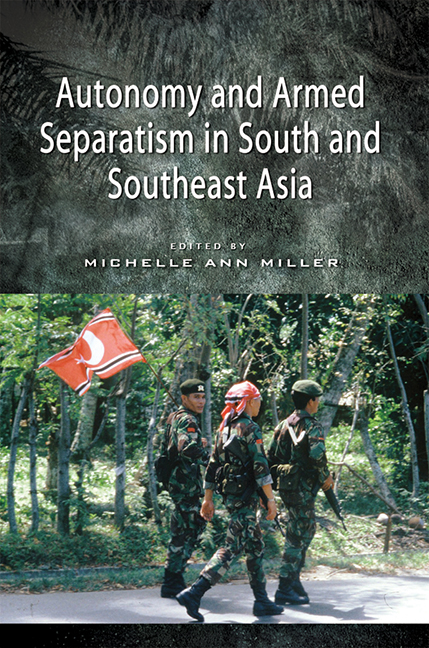Book contents
- Frontmatter
- Dedication
- Contents
- Acknowledgements
- About the Contributors
- 1 The Problem of Armed Separatism: Is Autonomy the Answer?
- 2 Mediated Constitutionality as a Solution to Separatism
- 3 Self-Governance as a Framework for Conflict Resolution in Aceh
- 4 Autonomy and Armed Separatism in Papua: Why the Cendrawasih Continues to Fear the Garuda
- 5 The Parallels and the Paradox of Timor-Leste and Western Sahara
- 6 Between Violence and Negotiation: Rethinking the Indonesian Occupation and the East Timorese Resistance
- 7 Struggle over Space in Myanmar: Expanding State Territoriality after the Kachin Ceasefire
- 8 Sri Lanka's Ethnic Conflict: The Autonomy-Separation Dialectic
- 9 Unitarianism, Separatism and Federalism: Competing Goals and Problems of Compromise in Sri Lanka
- 10 Autonomy and Armed Separatism in Jammu and Kashmir
- 11 Armed Conflicts and Movements for Autonomy in India's Northeast
- 12 Southern Thailand: The Trouble with Autonomy
- 13 The Last Holdout of an Integrated State: A Century of Resistance to State Penetration in Southern Thailand
- 14 Interlocking Autonomy: Manila and Muslim Mindanao
- 15 History, Demography and Factionalism: Obstacles to Conflict Resolution through Autonomy in the Southern Philippines
- 16 Conclusion
- Index
8 - Sri Lanka's Ethnic Conflict: The Autonomy-Separation Dialectic
Published online by Cambridge University Press: 21 October 2015
- Frontmatter
- Dedication
- Contents
- Acknowledgements
- About the Contributors
- 1 The Problem of Armed Separatism: Is Autonomy the Answer?
- 2 Mediated Constitutionality as a Solution to Separatism
- 3 Self-Governance as a Framework for Conflict Resolution in Aceh
- 4 Autonomy and Armed Separatism in Papua: Why the Cendrawasih Continues to Fear the Garuda
- 5 The Parallels and the Paradox of Timor-Leste and Western Sahara
- 6 Between Violence and Negotiation: Rethinking the Indonesian Occupation and the East Timorese Resistance
- 7 Struggle over Space in Myanmar: Expanding State Territoriality after the Kachin Ceasefire
- 8 Sri Lanka's Ethnic Conflict: The Autonomy-Separation Dialectic
- 9 Unitarianism, Separatism and Federalism: Competing Goals and Problems of Compromise in Sri Lanka
- 10 Autonomy and Armed Separatism in Jammu and Kashmir
- 11 Armed Conflicts and Movements for Autonomy in India's Northeast
- 12 Southern Thailand: The Trouble with Autonomy
- 13 The Last Holdout of an Integrated State: A Century of Resistance to State Penetration in Southern Thailand
- 14 Interlocking Autonomy: Manila and Muslim Mindanao
- 15 History, Demography and Factionalism: Obstacles to Conflict Resolution through Autonomy in the Southern Philippines
- 16 Conclusion
- Index
Summary
Do government offers for autonomy reduce the momentum for secession in a context of protracted civil war? Or, do incomplete autonomy measures provide new encouragement to secessionist projects? How can an autonomy solution be realistically feasible when the state emerges victorious in a protracted internal war against an armed insurgency launched on behalf of an ethnic minority? I explore these three questions in relation to the experience of Sri Lanka which has had an ethnic minority armed insurgency for secession spread over two and a half decades, from the early 1980s to 2009. The civil war came to an end in May 2009 when the armed forces of the Sri Lankan state militarily defeated the Liberation Tigers of Tamil Eelam (LTTE), which spearheaded the insurgency. Two factors concerning regional autonomy make the Sri Lankan case study interesting. The first is about the capacity/incapacity of the autonomy option to bring the conflict to an end when the civil war was raging. The second is the extent to which the government is willing to pursue the autonomy option after defeating the ethnic minority rebellion. This chapter explores the trajectories of the autonomy debate in Sri Lanka during and after the civil war.
Is regional autonomy a viable alternative to secession? The answer to this question emerged during the civil war has been a complex one. It had often been shaped by the ways in which the politics of the conflict was played out at the national, regional and global levels. Similarly, the secessionist project of the Tamil rebels and the limited autonomy offers made by governments have been two constitutive components of the protracted civil war. To elaborate on the point, the spread of the armed rebellion for secession in the Northern and Eastern provinces of the country compelled the governments of Sri Lanka to explore regional autonomy options. At the same time, half-hearted and minimalist autonomy offers by the government repeatedly reinforced the argument for secession.
- Type
- Chapter
- Information
- Autonomy and Armed Separatism in South and Southeast Asia , pp. 136 - 161Publisher: ISEAS–Yusof Ishak InstitutePrint publication year: 2012

